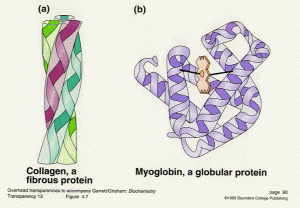Difference between globular protein and fibrous proteins
Globular Protein vs Fibrous Proteins
Proteins are the chemical nutrients that are required for building various tissues of the body as well as needed for repair of worn out cells. Proteins are classified into 3 main groups, namely globular proteins, fibrous proteins and membrane proteins.
Difference in structure
A Globular protein is spherical in shape and has the property of forming colloids with water. It gets dissolved in water. Globular proteins are also called as spheroproteins owing to their shape. Fibrous proteins are also called as scleroproteins. Fibrous proteins are elongated strand-like structures and are usually present in the form of rods or wires. Hemoglobin is an example of globular protein whereas keratin, collagen and elastin are all fibrous proteins. Keratin is found in hair, horns, nails, feathers etc.
An important differentiating feature is that fibrous proteins are insoluble in water, weak acids and weak bases but soluble in strong acids and alkalis whereas globular proteins are soluble in water, acids and bases. The peptide chains are bound together by strong intermolecular hydrogen bonds in fibrous proteins whereas in globular proteins they are held together by weak intermolecular hydrogen bonds. Scleroproteins do not denature as easily as globular proteins.
Fibrous proteins have primary and secondary structures. They are made up of a single unit or structure which is repeated multiple times. Fibrous proteins are highly resistant to digestion by enzymes and are extremely tensile. Globular proteins are made up of not only primary, secondary but also tertiary and occasionally quaternary structures. Globular proteins consist of straight chains of secondary structures which abruptly join polypeptide chains and change directions whereas fibrous proteins are made up of repetitive continuations of one small unit but multiple times.
Difference in functions
Globular proteins have multiple functions as they are used to form enzymes, cellular messengers, amino acids but fibrous proteins act only as structural proteins. Globular proteins are highly branched or coiled structures and are majorly responsible for transportation of vital nutrients like oxygen through hemoglobin. Globular proteins are the major source of hemoglobin, immunoglobins, insulin and milk-protein casein. They also are involved in the formation of amino acids which are basic building blocks of all proteins. They are needed for the formation of chemical messengers like hormones in the body. They are essential for the formation of transporters of other particles through the membrane. Myoglobin is another example of globular protein which is the chief protein found in muscles.
Fibrous proteins are needed for the formation of tough structures like connective tissue, tendons and fibers of the muscle. Collagen is a major component of all our connective tissues. Fibroin is a fibrous protein which is used to produce silk by silkworms and webs of spider. Fibrous proteins are responsible for the production of the movements of the muscles and tendons at a joint.
Summary:
Fibrous proteins and globular proteins differ in size, shape, solubility, appearance as well as in function. Fibrous proteins consist of repetition of a single unit to form chains that act as connective tissues and give strength and joint mobility. Globular proteins are spherical in shape and consist of long chains with numerous branches and offshoots which make them great as transport proteins. Examples of fibrous proteins are collagen, elastin, keratin, silk, etc. Examples of globular protein are myoglobin, hemoglobin, casein, insulin, etc.
- Difference between near sightedness and far sightedness - January 21, 2015
- Difference between Diverticulosis and Diverticulitis - January 20, 2015
- Difference between Prilosec and Nexium - January 19, 2015
Search DifferenceBetween.net :
7 Comments
Leave a Response
References :
[0]http://www3.nd.edu/~aseriann/fibglob.gif


thanks so much. this site is very helpful to me. I am student of university of fort hare. I am doing PhD . I RESEARCH ABOUT FUNCTION OF PROTEIN BASEDBCHEMISTRY. please I need your help. If there is a space in your work let me know. I need enough experience.
Wow,its So Great For This Kind Of Site,i Greatly Appreciate The Founder.Thanks For The Great Work That You Are Doing On This Site,i Really Appreciate!!!.Drake
tnx to easy way to understand…please continiue…
Thanks it was help full might helped a little more if structures were given
I would like to know which common everyday foods have predominately one type of protein or another.
Thanks in advance!–Mister Guthrie
It’s so hlpful for me thanks a lot
good work